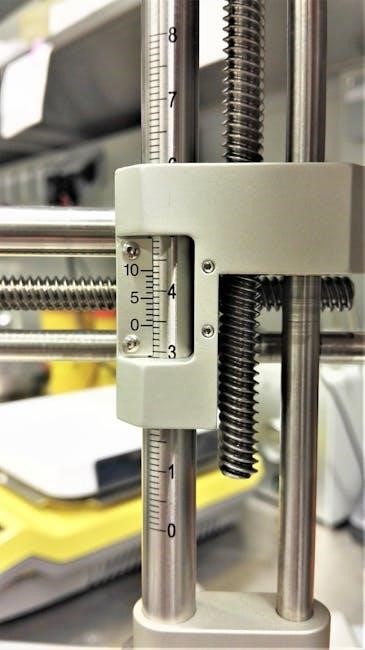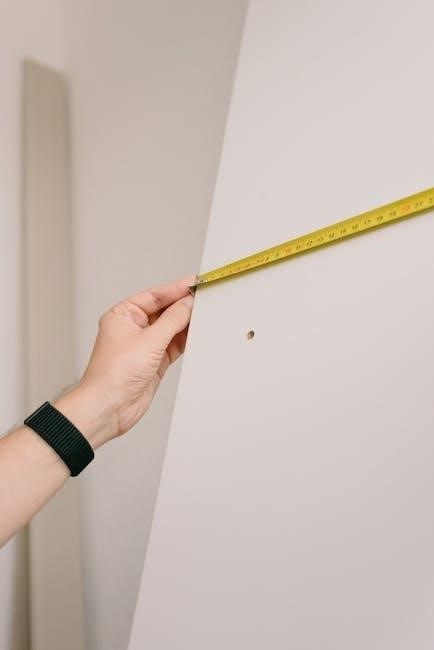Welcome to the Taylor Scale Manual, your comprehensive guide to understanding and using your scale effectively. This manual covers setup, features, and troubleshooting for optimal performance.
1.1 Overview of the Taylor Scale
The Taylor Scale is a high-quality, precision instrument designed for accurate weight measurement. Available in both digital and analog models, it offers user-friendly features and durability. This scale is ideal for personal or professional use, providing reliable results. Its sleek design and ergonomic build ensure ease of use and long-lasting performance. The Taylor Scale is adaptable to various needs, from basic weight tracking to advanced features like body fat analysis. This overview highlights its key characteristics and the importance of the manual in optimizing its functionality.
1.2 Importance of Reading the Manual
Reading the Taylor Scale Manual is essential for maximizing your scale’s potential. It provides detailed instructions for setup, operation, and troubleshooting, ensuring accurate measurements and longevity. The manual explains safety precautions, calibration processes, and how to use advanced features like BMI and body fat analysis. By following the guidelines, you can avoid errors and maintain the scale’s precision. Understanding the manual also helps you troubleshoot common issues, saving time and frustration. It is a comprehensive resource to ensure you get the most out of your Taylor Scale with confidence and efficiency.

1.3 Safety Precautions
Always place the Taylor Scale on a hard, level surface and avoid unsteady or soft surfaces to ensure accurate measurements. Keep the scale away from water and moisture to prevent damage or electrical issues. Handle the scale gently to avoid scratching or breaking the glass or digital components. Avoid overloading the scale beyond its maximum weight capacity, as this can cause damage. Regularly clean the scale with a soft cloth and mild soap to maintain hygiene. Follow all instructions carefully to ensure safe and effective use, and keep the scale out of reach of children and pets.

Understanding the Taylor Scale Features
Explore the Taylor Scale’s features, including digital and analog options, key functions, and special modes like weight, BMI, and body fat measurements for comprehensive health tracking.
2.1 Digital vs. Analog Taylor Scales
Taylor offers both digital and analog scales, catering to different user preferences. Digital scales provide precise weight measurements, LCD displays, and advanced features like BMI and body fat tracking. Analog scales, while more traditional, offer simplicity and reliability. Digital models often include additional functions such as Bluetooth connectivity and voice features, making them ideal for tech-savvy users. Analog scales, however, are straightforward and require minimal setup. Choose the option that best fits your needs for accurate and efficient weight monitoring.
2.2 Key Functions and Buttons
Your Taylor scale features intuitive controls designed for seamless operation. The power button turns the scale on/off, while the zero/reset button calibrates the scale or resets it for a new measurement. Additional buttons allow you to switch between units (lbs/kg) or access special modes like BMI or body fat analysis. Some models include a voice feature button for hands-free operation. The LCD display navigates through modes effortlessly, ensuring accurate and efficient weight tracking. Familiarize yourself with these buttons to unlock your scale’s full potential and enjoy a user-friendly experience.
2.3 Special Modes (e.g., Weight, BMI, Body Fat)

Your Taylor scale offers advanced modes to track more than just weight. The BMI mode calculates your body mass index, providing a health indicator. Body fat analysis measures fat percentage using bioelectrical impedance. Some models also include a voice feature for hands-free operation. These modes enhance your ability to monitor progress toward fitness goals. Ensure accurate results by inputting your height, age, and gender before using these features. Regular use of these modes helps you gain a comprehensive understanding of your health and wellness journey, making your scale a valuable tool for long-term success.

Setting Up Your Taylor Scale
Unpack and place your scale on a firm, level surface. Install batteries as instructed and calibrate for accurate measurements; Follow the manual for a seamless setup process.
3.1 Unpacking and Placement
Begin by carefully unpacking your Taylor Scale, ensuring all components are included. Place the scale on a hard, level, and dry surface, away from direct moisture. Ensure the area is stable to prevent any imbalance. Avoid placing the scale on soft surfaces like carpets, as this may affect accuracy. Gently remove any protective covering from the platform and ensure it is clean before use. Proper placement is essential for reliable measurements and longevity of your scale.
3.2 Battery Installation and Power Management
Insert the required AA batteries into the compartment located on the underside of the scale. Ensure the batteries are high-quality and correctly aligned with the polarity indicators. Avoid mixing old and new batteries or using rechargeable types. If your scale has a low-battery indicator, it will alert you when power is low. To conserve energy, the scale features an auto-turnoff function, deactivating after a period of inactivity; Proper battery management ensures accurate measurements and extends the life of your Taylor Scale.
3.3 Calibration Process
Calibrating your Taylor Scale ensures accurate weight measurements. Place the scale on a firm, level surface and turn it on. Press and hold the calibration button until the display shows “CAL” or “0.00.” Release the button and wait for the scale to reset. For models requiring a calibration weight, place the weight on the platform and follow the on-screen instructions. Ensure no additional weight is on the scale during calibration. Proper calibration is essential for precise readings and optimal performance of your Taylor Scale.
Using the Taylor Scale
Place the scale on a level surface, turn it on, and step onto the platform. The scale will display your weight accurately and efficiently, ensuring ease of use.

4.1 Step-by-Step Weighing Guide
Ensure the scale is placed on a firm, level surface. Turn it on and wait for the display to activate.
Stand on the center of the platform with bare feet for accurate readings.
Remain still until the measurement is complete. The scale will automatically turn off after use.
For body fat and BMI measurements, input your height, age, and gender using the buttons.
Record your data to track progress over time. Regular use helps monitor weight management goals effectively.
4.2 Reading and Understanding the Display
The Taylor Scale display shows your weight in clear, large numbers. Additional metrics like BMI and body fat percentage are displayed if selected. A checkmark appears when measurements are complete. Units (lbs/kg) are indicated in the corner. For body fat, a percentage and classification (e.g., normal, high) are shown. The display also alerts you to low battery or error codes. Understand each symbol and number to make informed decisions about your health and weight management goals. Refer to the manual for a full list of symbols and their meanings.
4.3 Data Tracking and Monitoring Progress
Regularly tracking your weight and health metrics helps monitor progress toward your goals. The Taylor Scale stores historical data for multiple users, allowing you to track changes over time. Use the weight history feature to view past measurements and assess trends. For added convenience, sync your data with the WeighSync app via Bluetooth. This app generates charts and provides insights into your progress. Monitoring your data helps you stay motivated and make informed adjustments to your diet or exercise routine. Consistent tracking is key to achieving and maintaining your health objectives.

Advanced Features of the Taylor Scale
The Taylor Scale offers advanced features like Bluetooth connectivity, app syncing, and voice commands for hands-free operation, enabling seamless data tracking and enhanced user convenience.
5.1 Bluetooth and App Connectivity
Experience seamless connectivity with the Taylor Scale’s Bluetooth feature, allowing you to sync your weight data to the WeighSync app. This feature enables easy tracking of your progress, setting goals, and monitoring trends over time. The app compatibility ensures your data is stored securely and can be accessed anytime, making it easier to share with healthcare professionals or fitness coaches. This advanced connectivity enhances your weight management journey, offering a comprehensive digital solution for a healthier lifestyle.
5.2 Multiple User Profiles
The Taylor Scale supports multiple user profiles, allowing different household members to track their weight and health metrics separately. Each profile can be personalized with unique IDs, ensuring data privacy and accuracy. This feature is ideal for families or shared spaces, as it maintains individual progress tracking and provides a convenient way to monitor personal health goals. The scale automatically recognizes each user, offering a seamless and organized experience for everyone. This function enhances usability and makes it easier to manage health data for multiple individuals in one place.
5.3 Voice Feature for Hands-Free Operation
The Taylor Scale’s voice feature provides hands-free operation, allowing users to hear their weight measurements without looking at the screen. This feature enhances convenience by speaking measurements aloud, making it ideal for hands-free use or for individuals with visual impairments. Users can adjust the volume and choose between different languages for a personalized experience. This innovative feature improves accessibility and ensures a seamless experience for all users.

Maintenance and Care
Regular maintenance ensures your Taylor Scale performs accurately. Clean the surface with a soft cloth, avoid harsh chemicals, and store it in a dry place to prevent damage.
6.1 Cleaning the Scale
Keep your Taylor Scale in optimal condition by cleaning it regularly. Use a soft, dry cloth to wipe the platform and surface. For stubborn stains, dampen the cloth slightly with water, but avoid excessive moisture. Never use harsh chemicals, abrasive cleaners, or rough materials, as they may damage the finish or sensors. For electronic models, gently clean the buttons and display with a lint-free cloth. Regular cleaning ensures accurate readings and extends the lifespan of your scale. Always refer to the manual for specific cleaning instructions tailored to your model.
6.2 Storing the Scale Properly
Proper storage is essential to maintain your Taylor Scale’s performance and longevity. Store the scale in a cool, dry place, away from direct sunlight and moisture. Avoid extreme temperatures, as they may affect accuracy. For models with batteries, remove them before long-term storage to prevent leakage. Place the scale in its original packaging or a protective cover to shield it from dust and damage. Ensure the surface is flat and stable during storage. Always follow the manufacturer’s recommendations for storing your specific Taylor Scale model to preserve its functionality and ensure reliable use when needed.
6.3 Replacing Parts (e.g., Batteries, Feet)
Regular maintenance may require replacing parts like batteries or feet to ensure optimal performance. For batteries, use the type specified in your manual and install them correctly. If replacing feet, ensure they are securely attached to maintain stability. After replacement, recalibrate the scale for accuracy; Always handle the scale gently to avoid damage. Proper replacement of parts ensures your Taylor Scale remains reliable and accurate for years to come.

Troubleshooting Common Issues
Troubleshooting common issues with your Taylor Scale involves checking error codes, ensuring proper calibration, and verifying battery levels. Refer to your model-specific manual, such as Taylor 7209W or 7560, for detailed solutions to ensure accurate measurements and resolve problems efficiently.
7.1 Error Codes and Solutions
Understanding error codes on your Taylor Scale is crucial for resolving issues. Common codes include E1 (sensor issue), E2 (overload), and LO (low battery). For E1, restart the scale or clean the sensors. E2 indicates excess weight; remove items and retry. LO requires replacing or charging batteries. Refer to your model-specific manual (e.g., Taylor 7209W or 7560) for detailed solutions. If problems persist, reset the scale or contact customer support for assistance. Regular maintenance and calibration can prevent many of these errors, ensuring accurate measurements and optimal performance.
7.2 Resetting the Scale
To reset your Taylor Scale, turn it off and press the Zero or Reset button while turning it back on. For models like the Taylor 7209W, insert a small object (e.g., a paperclip) into the reset hole on the underside. Hold until the display shows ZERO or RESET. Release and allow the scale to recalibrate. This process restores factory settings and resolves many operational issues. Always refer to your specific model’s manual (e.g., Taylor 7560) for precise instructions, as reset procedures may vary slightly between models.
7.3 Addressing Accuracy Problems
Ensuring accuracy is key to getting reliable readings from your Taylor Scale. If your scale shows inconsistent or incorrect measurements, check if it is placed on a hard, level surface. Avoid soft or uneven surfaces, as they can disrupt weight detection. Next, recalibrate the scale by pressing the Zero button until it displays ZERO or 0.0. If issues persist, verify that the scale is on a flat surface and that no debris or moisture is interfering with the sensors. For severe accuracy problems, refer to the troubleshooting section or contact customer support.
Taylor Scale Models
Explore Taylor’s diverse range of scales, from the Taylor 7209W Digital Scale to the 7560 Electronic Scale and versatile kitchen scales like the TE10R, each designed for precision and ease.
8.1 Taylor 7209W Digital Scale
The Taylor 7209W Digital Scale is a high-quality, user-friendly device designed for accurate weight measurement. It features a large LCD display, durable construction, and a sleek, modern design. With its advanced Cal-Max technology, it ensures precise readings up to 400 lbs (180 kg) in 0.1 lb (0.1 kg) increments. The scale is powered by two AAA batteries and includes an auto-shutoff feature to conserve energy. Ideal for personal use, the Taylor 7209W combines reliability and style, making it a great choice for home or professional settings. Its compact footprint and lightweight design allow easy placement and portability.
8.2 Taylor 7560 Electronic Scale
The Taylor 7560 Electronic Scale is a versatile and advanced model designed for precise weight measurement. It features a sleek, modern design with a large, backlit LCD display for easy readability. Equipped with voice command functionality, this scale offers hands-free operation, making it convenient for users. It supports multiple profiles, allowing different household members to track their progress separately. The scale also includes Bluetooth connectivity, enabling seamless data syncing with the WeighSync app for comprehensive health monitoring. With its durable construction and high weight capacity, the Taylor 7560 is an excellent choice for both personal and professional use.
8.3 Taylor Kitchen Scales (e.g., TE10R)
Taylor Kitchen Scales, such as the TE10R model, are designed for precision and ease of use in culinary settings. The TE10R features a digital LCD display, providing accurate measurements for ingredients. It offers unit conversion between grams, ounces, and pounds, making it versatile for various recipes. The scale is compact, lightweight, and built with a durable design for long-lasting performance. With a tare function and automatic shut-off, it enhances usability while preserving battery life. Ideal for both amateur and professional chefs, the TE10R ensures precise measurements, making it an essential tool for cooking and baking.
FAQs About the Taylor Scale
Frequently Asked Questions about the Taylor Scale provide quick answers to common inquiries, ensuring smooth operation and troubleshooting. This section addresses user concerns effectively.
9.1 How to Reset the Scale to Factory Settings
To reset your Taylor Scale to factory settings, press and hold the reset button for 5 seconds. Turn the scale off, wait 10 seconds, and turn it back on. This restores default settings, ensuring accurate measurements. If issues persist, refer to your manual for model-specific instructions. Resetting clears all saved data, so ensure your information is backed up before proceeding. This process helps resolve most software-related issues and recalibrates the scale for precise performance.
9.2 Can the Scale Be Used on Any Surface?

The Taylor Scale is designed for use on hard, flat surfaces to ensure accuracy. Avoid placing it on soft or uneven surfaces, as this may affect weight readings. For optimal performance, position the scale on a level, stable surface such as a tile or hardwood floor. Carpeted or uneven areas can cause inaccuracies. Always follow the manufacturer’s guidelines for surface requirements to maintain precise measurements and extend the scale’s lifespan. Proper placement is key to reliable and consistent results.
9.3 How to Sync Data with the WeighSync App
To sync your Taylor Scale with the WeighSync App, ensure Bluetooth is enabled on your device. Open the app, select “Add Device,” and choose your scale from the list. Follow the on-screen instructions to complete the pairing process. Once connected, your weight data will automatically transfer to the app. For troubleshooting, restart the scale, check Bluetooth connectivity, or reinstall the app. Regular syncing helps track your progress and maintain accurate records. This feature enhances your fitness journey by integrating data seamlessly.
Congratulations on completing this guide! You’re now equipped to use your Taylor Scale effectively. Regular maintenance ensures accuracy and longevity. For further assistance, consult the Taylor website or contact support. Happy weighing and tracking your progress!
10.1 Final Tips for Optimal Use
- Always calibrate your scale on a hard, level surface for accurate readings.
- Use the scale barefoot or with thin socks for precise body composition measurements.
- Clean the scale regularly with a soft cloth to maintain its performance.
- Ensure the scale is placed on a firm, non-carpeted surface for stability.
- Check battery levels regularly to avoid sudden power loss during use.
- Use the correct units (lbs/kg) as set during calibration for consistent results.
- Explore advanced features like app syncing for comprehensive health tracking.
10.2 Importance of Regular Maintenance
Regular maintenance ensures your Taylor scale remains accurate and functions optimally. Clean the scale with a soft cloth and avoid harsh chemicals to preserve its surface. Check and replace batteries as needed to prevent sudden malfunctions. Store the scale properly when not in use to avoid damage. Regular calibration also maintains accuracy over time. By following these simple steps, you extend the lifespan of your scale and ensure reliable performance for years to come.
10.3 Resources for Further Assistance
For further assistance, refer to the official Taylor website, which offers detailed manuals, troubleshooting guides, and FAQs. Contact customer support directly for personalized help. Additionally, the WeighSync app provides interactive support and data management. Online forums and tutorials can also offer tips and solutions from experienced users. Regularly check for firmware updates to ensure your scale operates at its best. If you encounter issues, visit the Taylor support page or consult authorized service centers for professional assistance.

